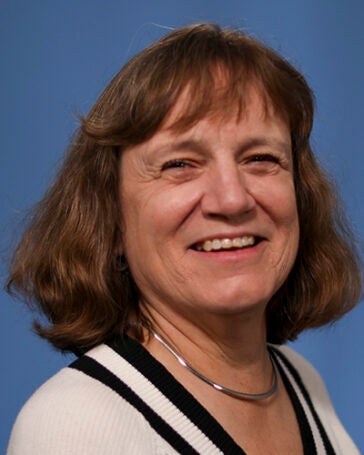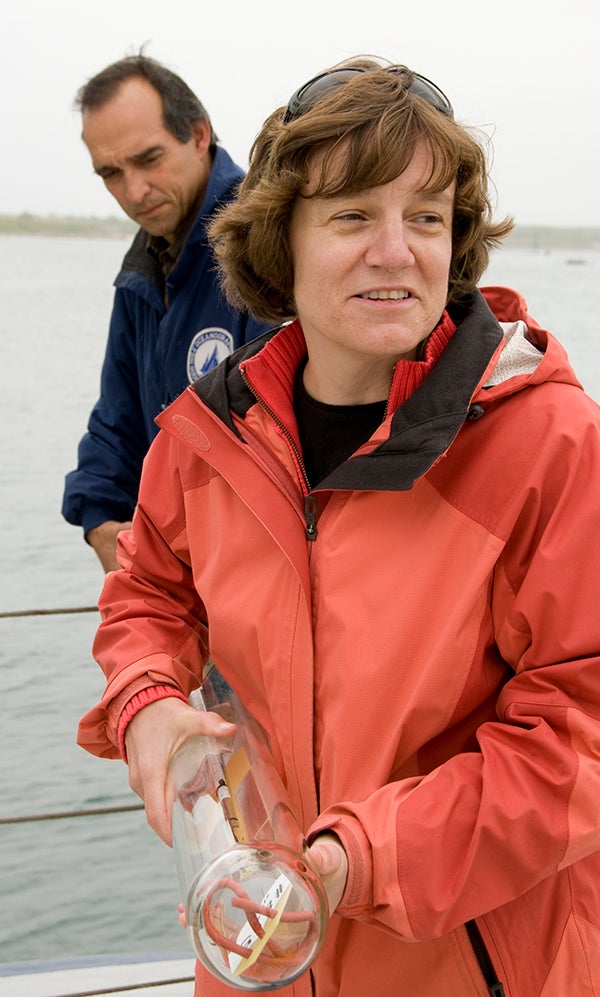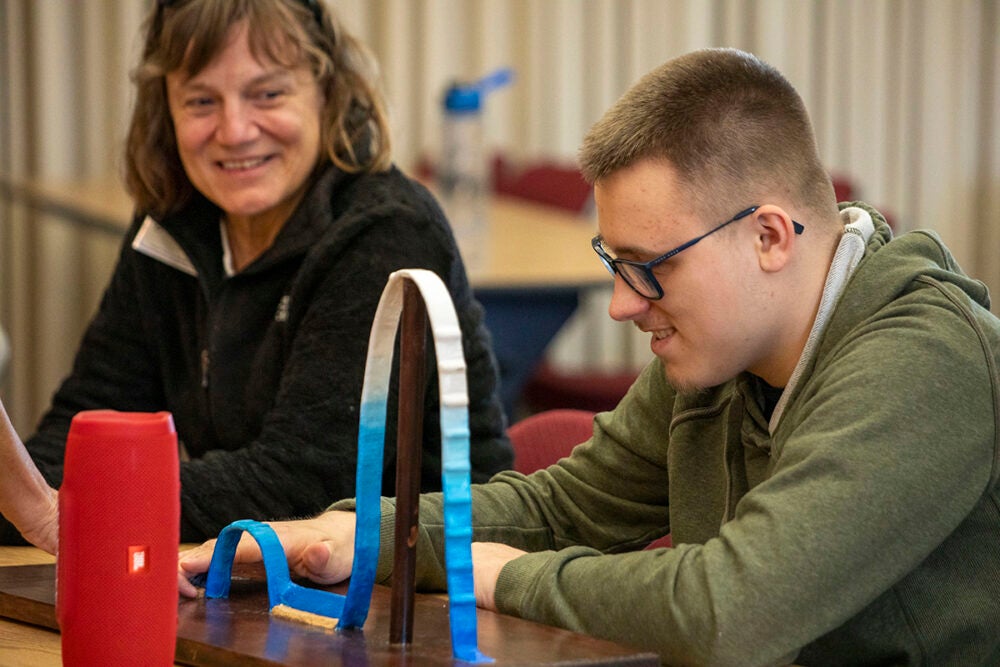By Veronica M. Berounsky, Ph.D. ’90

Amy Bower, Ph.D. ’88, knew she wanted to be an oceanographer ever since she participated in a summer marine science field course in her hometown at the age of 13. Nothing—not pirates nor the loss of her vision—would stop her from achieving that dream. Today, Bower is a senior scientist in the Physical Oceanography Department at the Woods Hole Oceanographic Institution (WHOI). In January she will be honored with the 2025 Henry Stommel Research Medal, the highest honor that the American Meteorological Society presents to oceanographers. Not only has she achieved her goal of being a sea-going oceanographer, she has also earned recognition from her peers for her extensive, critical body of work that focuses on understanding the ocean’s circulation, deep water currents, and the Atlantic Meridional Overturning Circulation.

While pursuing an undergraduate degree in physics at Tufts University, Bower’s focus was on the ocean. So when an opportunity arose to attend an oceanography conference at the University of Rhode Island’s Graduate School of Oceanography, she seized it. Although GSO Professor Tom Rossby was away at that time, Bower connected with him and landed a summer undergraduate research fellowship in oceanography. That summer was spent testing a new oxygen sensor that Rossby was considering including on RAFOS floats. RAFOS (Sound Fixing And Ranging spelled backwards) floats, which were just being developed, listen for sound signals to track ocean water movement and also carry sensors to measure pressure, salinity and temperature.
Bower returned to Tufts in the fall and finished her studies in December, eager to begin her next step: a Ph.D. program with Rossby that would start in January, 1981. Reflecting on her early years at GSO, Bower says, “Starting in my first year, I was involved in research expeditions to the Gulf Stream, where I learned to use RAFOS floats to study its three-dimensional velocity structure. I loved graduate school right from the beginning. Especially the research cruises because of the adventure, the sense of exploration, and the camaraderie that develops during remote field work. I was hooked on physical oceanography.”
“What a cheerful and positive person she was and still is,” Rossby said. “She was inquisitive, asking questions, suggesting ideas, always part of the give and take in any discussion. Her work led to a widely cited paper called ‘The Gulf Stream—Barrier or Blender?’”
Everything was going well, until Bower’s third year at GSO, when a routine eye exam discovered an unusual blind spot. She was diagnosed with macular degeneration and retinitis pigmentosa, with the prognosis that she would eventually become partially or fully blind. The ophthalmologist suggested that Bower become an administrator, not a researcher. The diagnosis, and particularly the career suggestion, was devastating; she didn’t know any blind people, never mind blind oceanographers.

Determined to continue her career, Bower focused her energy on exploring options and solutions. She found a low-vision specialist with a positive attitude, who was also a sailor. He introduced her to technologies that help people with low-vision reading and writing, such as magnifiers and special monitors, and they discussed living and working on the ocean.
Research cruises were crucial to her graduate work. As Rossby noted, “The 1984-85 RAFOS float study of the Gulf Stream became the focus of her research. Her analyses led to two widely cited papers published in 1989, the first one focusing on the kinematics of the trajectories, and the second offering a novel potential vorticity analysis. Bower and I were both convinced there must be some way to express the float trajectories analytically, but without success.”
In 1988, Bower finished her research and graduated with a Ph.D. “It was later as a postdoctoral fellow at WHOI that Amy came up with a brilliant solution to the analytical problem,” Rossby said. “I was both envious and proud of her.” Rossby and Bower continue to stay in touch to discuss research.
By the time Bower finished her postdoc, her vision was limited. However, she continued to do research, knowing that research vessels are relatively easy to navigate for someone with low vision because of the confined spaces and secured equipment. She made one concession—she avoided on-deck research.
In 2004, the National Science Foundation began requiring inclusion of “broader impacts”—the potential of a project to benefit society—within grant applications. Bower saw this as an opportunity to reach out to blind students and show them what they could achieve, including becoming scientists.
In 2006, she connected with Kate Fraser, a science teacher at that time at the Perkins School for the Blind in Watertown, Mass. Bower’s interactions with the school continues today, including visits to speak with students, writing a blog for the school, and hosting students for interactive visits at WHOI. One time, Fraser even joined Bower on a research cruise. Bower was determined that Perkins School students would not experience the same isolation that she did as a visually impaired aspiring scientist.

These visits to WHOI have become an annual event for blind and low-vision students. Bower has expanded her efforts through programs like “OceanInsight,” which serves blind and visually impaired learners of all ages. She started “Accessible Oceans” in 2021 to introduce nontraditional and nonvisual ways to make ocean science more available to all. In 2024 she published a paper on using sound to interpret data and has also been working on tactile ways to represent data, such as raised dots.
Meanwhile, Bower continues her research. She paused her cruises while she served as chair of WHOI’s Physical Oceanography Department but is looking forward to a research cruise to the Grand Banks off Newfoundland scheduled for next May. Once again, she’ll work with RAFOS floats, a technology that has now been around for 40 years.
This fall, Bower took on a new postdoctoral fellow, Ali Johnson Exley, M.S. ’20, Ph.D. ’24. Previously, Bower mentored Rossby student, Paula Perez-Brunius, Ph.D. ’02, as a research associate in 2002-03. Bower is continuing the important mentorship she received from Rossby.
When Exley was asked why she chose to work with Bower, she said, “Amy is a pioneer in the field of physical oceanography. She has revolutionized our understanding of pathways within the Atlantic Meridional Overturning Circulation and made groundbreaking observations in the deepest and most understudied regions of our global oceans. She has made such significant contributions all while breaking barriers and making the field more accessible and inclusive to women and to those with disabilities.”
Bower’s determination and contributions to oceanography have not only advanced the field, but expanded our vision of who can be an oceanographer and what oceanographic data can look like.
As for those pirates? In August 2001, while conducting research off the coast of Somalia, Bower’s research ship was chased by a small boat of pirates firing rifles and grenades and intent on boarding the ship. Fortunately, the research vessel outran them. As the chief scientist, it was Bower’s responsibility to keep the scientists calm and then keep the research going, which she, of course, did.
